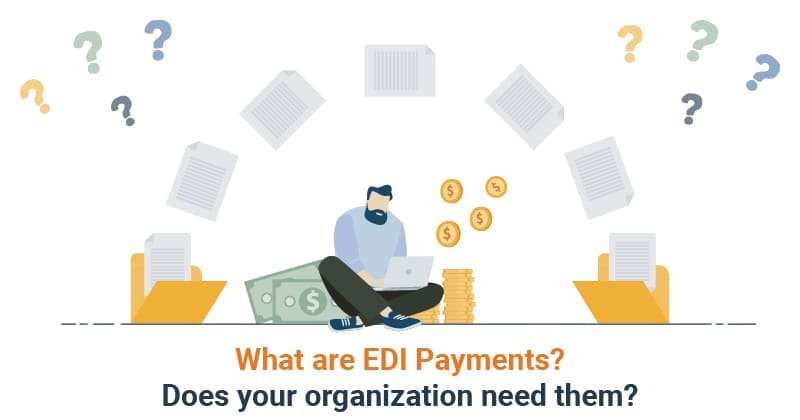What Are EDI Payments? Does Your Organization Need Them?
 Jim Schwab
Jim Schwab
Table of contents
Data regulations are a mandate across industries. Protecting crucial information exchange regarding invoices, customer information, and vendor bank information is important not just for enterprises but even small to medium businesses. The manual exchange of data via traditional methods can result in errors, data breaches, and delays in your operations, among other challenges. Electronic data interchange (EDI) and application integration is the digital way forward that can help businesses streamline operations, connect their applications, and also securely transmit payment-related information to their customers and partners.
STAEDEAN has 17+ years of experience offering solutions for Microsoft-based ERPs. We have helped several customers with electronic data interchange – using EDI Studio and application integration – with Data Integration Solution for Dynamics 365 Finance & Supply Chain Management (D365 F&SCM).
As EDI experts, we have spoken to our customers over the years about what EDI is and the types of documents exchanged. In this blog, we will shed some light on the subject of EDI payments, for those of you new to the world of EDI.
What are EDI payments?
An electronic data interchange or EDI payment is the exchange of transaction-related information and should not be mistaken for the exchange of currency. An EDI payment uses globally accepted standards to transmit payment data between your customers, suppliers, and trading partners. Since EDI payments are quick and use a consistent way of exchanging data, businesses across industries use it via a direct connection to their trading partners, or they outsource the EDI connections via VANs/brokers.
In EDI, there are several protocols available that use a secure means to transmit data between parties. For example, protocols such as AS2 use digital certifications and encryption, SFTP allows you to transfer data across a secure channel, and HTTPS uses HTTP and SSL/TLS security to provide encryption and security for message transmission. Additionally, you can request a transmission acknowledgment that confirms that your trading partner has received the expected document without errors.
EDI replaces paper-based traditional methods of exchanging sensitive information and offers businesses a secure way to keep track of all their transactions between multiple trading partners. STAEDEAN’s EDI Studio solution, for example, has a history management feature that can help you easily trace products exchanged in the past in case of a product recall and also anticipate demand based on past transactions.
What payment-related information is exchanged using EDI messages?
Sensitive data regarding payments is usually shared in these EDI payment messages. The documents comprise some or most of the below-mentioned items.
- Details of the payer and payee: Name and address
- Payment information: Credit/debit card or bank information
- Transaction details: invoice number, reference number, purchase order number
- Currency: The total amount in the currency to be exchanged
- Other details: the payment/remittance date
What is an example of an EDI Payment message?
Several important business documents are exchanged that contain payment-related information. Some examples of EDI messages that come under this category are:
- Remittance information
- Invoices
- Purchase orders
- Inventory and customs documents
- Shipping notices
- Bills of lading
How can you exchange EDI payment messages?
Whatever your EDI message, whether it is your product catalog or an invoice, you can use different scenarios to connect to your trading partners.
Direct: If you decide to go with a direct scenario, you can connect with an EDI solution provider such as STAEDEAN and implement the solution in-house. But you will also have to maintain all the connections to each of your trading partners, which can become a cumbersome task as the number of partners and transactions increase.
Via a VAN/Broker: VAN stands for Value added network and VAN providers can host and maintain all your connections and help you transmit your messages securely. However, with a broker, you have the advantage of additional services such as translation of EDI standard formats. If you want more information on VAN providers versus brokers, read our blog which also outlines beneficial scenarios for using each of them.
What are the benefits of using EDI for payment-related document exchange?
EDI offers a host of benefits besides streamlining business communications with your customers, suppliers, and other business partners. Below is the list of benefits that you can expect to achieve after switching to EDI:
- A secure and efficient way of exchanging documents. An EDI solution also allows you to keep track of all documents exchanged and also share documents quickly and securely.
- If you decide to go with integrated EDI, you can connect your business systems, ERP, and EDI solution and improve processing time from order to delivery.
- Since some EDI solutions, such as EDI Studio, provide you with a means to validate orders
and have a system to flag errors, it makes transactions error-free, and you have lesser delays and happier customers and partners. - Since your team will be spending lesser time exchanging manual documents, they will have more time to work on other important tasks
Related reading: How Can Electronic Data Interchange Increase Your Business Efficiency?
What is mistaken as EDI payments?
Often EDI, electronic funds transfer (EFT), and automated clearing house (ACH) are mistaken as similar processes, but they can be used together to facilitate the payment information and the payment. So, while EDI helps exchange bank details, payee name, and other important details, EFT is an act that protects consumer rights and defines the bank’s responsibilities to monitor electronic fund transfers. And ACH is a type of electronic payment under EFT that you can use to make a payment between banks.
The reason why ACH and EDI are often mistaken as the same is because they both include remittance information. Additionally, ACH uses the EDI format for information such as payee details. An ACH transaction is an electronic fund transfer that can include a direct deposit or a business transaction between partners.
Can you see an EDI payment on your bank statement?
It is possible to see an EDI message on a bank statement when your business and your trading partner have exchanged a payment-related message digitally. Some banks offer this service based on the account that you have with them and this service might vary from bank to bank as well. If you’re keen on seeing payment-related EDI messages on your bank statement, talk to your bank and see what they have to offer.
Are you ready to dive further into the world of EDI?
If you are new to the world of EDI, the terms used by EDI veterans, such as AS2 and EDIFACT, can get a little overwhelming. Our glossary is a great place to start to understand the protocols, standards, and other terms associated with EDI.
If this blog has piqued your interest and you are ready to take the plunge and learn more about EDI, then we recommend reading our complete beginner’s guide to everything EDI – EDI Toolkit. It covers everything from types of EDI providers to the best scenarios for you to choose from, and the benefits of using an integrated EDI solution. Go ahead and download your free copy of the EDI Toolkit from the link below!

